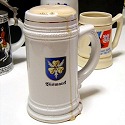
Notes Taken at a Conference of the Commander in Chief, Navy, with the Führer in his Headquarters at Vinnitsa on 26 February 1943.
1. A brief discussion by the Commander in Chief, Navy, concerning the submarine situation.
The month of February may be considered as typical for present submarine warfare.
During 14 days at sea nothing was sunk because nothing was sighted.
Three reasons may be advanced: bad weather and poor visibility, possibly the location of the submarines position by the enemy, but above all, the complete absence of our own reconnaissance.
Maps were brought along to illustrate what areas could be covered by various types of long-range reconnaissance planes.
It was reported to the Führer that the problem of air reconnaissance had been discussed with the Reichsmarschall and that he had promised his support, but said that the construction of long-range air reconnaissance planes would have to be given priority.
The Führer sharply criticized promises which were readily made regarding the performance and range of certain types of reconnaissance planes, which later proved illusory.
He does not believe that much will be gained by rebuilding the HE 177.
At the request of the Commander in Chief, Navy, the Führer promised to find out whether the three BV 222 could not be made available immediately for submarine reconnaissance in the West.
2. The Commander in Chief, Navy, reports as follows:
The Führer has previously decided that we cannot afford to let our large ships lie idle, since they are not in a position to engage in combat.
As a result of this decision, the following were decommissioned: the HIPPER, the LEIPZIG, and the KÖLN.
These will be followed shortly by the SCHLESIEN and the SCHLESWIG-HOLSTEIN.
The Commander in Chief, Navy, is however, of the opinion that the Archangel convoys would make excellent targets for the large ships, and he considers it his duty, in view of the heavy fighting on the eastern Front, to exploit these possibilities to the fullest extent.
He therefore considers it essential that the SCHARNHORST be sent to Norway to strengthen the forces there.
The TIRPITZ, the SCHARNHORST, and for the present the LÜTZOW, together with six destroyers, would be a fairly powerful task force.
The Führer, however, is strongly opposed to any further engagements of the surface ships since, beginning with the GRAF SPEE, one defeat has followed the other.
Large ships are a thing of the past.
He would prefer to have the steel and nickel contained in these ships rather than send them into action again.
When the Commander in Chief, Navy, mentioned that ships were severely limited by the imposed restriction that they must not be sacrificed, and that therefore, commanding officers of ships at sea could not be censured, the Führer replied, that he had never issued an order restricting commanding officers in this manner.
If in contact with the enemy, ships must go into action.
However, he no longer valued their effectiveness.
By way of contrast he explained how bitterly the men fought on the eastern Front and how unbearable it was to see the strength of the Russians constantly increased by convoys, like the last one of 25 ships, reaching their destinations.
Thereupon the Commander in Chief, Navy, declared that, instead of decommissioning the two heavy ships, he would consider it his duty to send them into action whenever possible and as long as suitable targets could be found.
The Führer finally agreed to let the SCHARNHORST join the task force, as recommended by the Commander in Chief, Navy.
He asked how long it would be before a suitable target would be found.
The Commander in Chief, Navy, thought in the next three months.
The Führer replied: "Even if it should require six months, you will then return and be forced to admit that I was right."
3. Since so little is to be gained by using Italian Atlantic submarines as supply ships, the Führer decided not to ask for them.
4. The Commander in Chief, Navy, reports that the Japanese Admiral Nomura had mentioned that the Japanese Navy was planning to use submarines against merchant shipping and that he had asked Ambassador Oshima and Foreign Minister v. Ribbentrop to request that two German submarines be put at Japan's disposal.
The Commander in Chief, Navy, explained that nothing would be gained in a military way by turning over the submarines, since he did not believe that they could be produced in large numbers in Japan because they lacked the necessary materials.
The Führer favored the idea of releasing one submarine partly to repay the shipments of rubber from Japan.
It would be easier for us to give up a submarine than high grade steel and finished products, such as machine tools.
He will not decide the matter until he is asked directly.
5. In order to reduce the loss of ships supplying Tunis, the Commander in Chief, Navy, considers it necessary to mobilize not only all anti-submarine craft in the area of southern France, but also to obtain similar vessels located in Italian ports.
Here there must still be ships, such as private yachts, which could be used for this purpose.
Admiral Meendsen-Bohlken has been ordered to take up this question with the Italian Naval Command.
It would be best if these vessels were manned by Germans, provided that this can be done without hurting the feelings of the Italians.
It must first be ascertained whether such craft are available, then the matter of manning the ships can be taken up.
The Führer agrees.
He will write to the Duce after the facts have been established.
The Führer criticizes the delay in organizing the 22nd Anti-Submarine Flotilla.
More German workers should have been assigned to complete its construction in time.
countersigned: Korvettenkapitän Pfeiffer
|
 BOOK: The Battleship Bismarck. The Complete History of the Ship.
 Naval & military gifts
|
